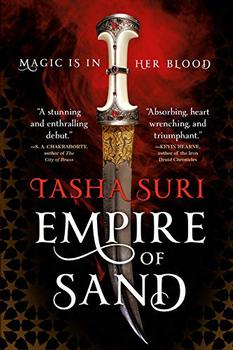Summary | Excerpt | Reading Guide | Reviews | Beyond the book | Read-Alikes | Genres & Themes | Author Bio

A Novel
by Anita AmirrezvaniWith the publication of Khalid
Hosseini’s
The Thousand Splendid Suns and Lisa See’s
(author of
The Snow Flower and Secret Fan)
newest novel,
Peony in Love, it might be easy to overlook
a hidden gem in Amita Amirrezvani’s new novel,
The Blood of Flowers. I began the book early in
the morning and could not come up for air until I
had finished all 384 pages. Part Arabian nights
fairytale, part historical fiction, and part
feminist treatise, this novel combines different
motifs in a delightful and captivating manner.
Written in plain, earthy, yet colorful prose,
interspersed with Persian folktales, Amirrzvani's
strengths come from her ability to make the sounds,
smells, and architecture of this ancient Persian
world come alive. My only complaint was that I found
myself impatient with the interspersed scattering of
the folktales; I longed to return to the ongoing
suspense of the narrative. However, this annoyance
was minor compared to the richly colored world of
carpet making and women's lives so aptly expressed.
In the story, the young female protagonist is forced
at one point to submit to a temporary marriage known
as "sigheh", a practice that still exists in Iran
today (see below). As a woman, being able to design
and knot carpets does not ensure a stable economic
future, so she must sublimate her needs for her
family and her own happiness. Her role is not
dissimilar to that of subservient women who are
treated as second-class citizens in their respective
countries today.
Arrezvani moves the story forward at a rapid pace by
putting the narrator through a series of trials and
tribulations that keep the reader transfixed. The
book's universal themes of tragedy and perseverance,
coupled with the everyday stories of Iranian women’s
lives in the bazaars, houses, and hamans make for a
sparkling treasure.
Reviewed by Lani, a BookBrowse member since
January 2006.
About Sigheh
The heroine of The Blood of Flowers ends up
in a temporary marriage called a sigheh. Like many
aspects of Islam the sigheh is not only
controversial but open to interpretation. The
practice, which is still alive and well in many
parts of the Muslim world, dates back before Islam
to Arab tribes, particularly to those involved in
long distance trade. Sigheh allows a man and woman
to marry for a temporary period. While a man is
limited to four permanent wives there are no limits
on the number of temporary wives he can have.
The children born of a sigheh marriage are
considered legitimate (assuming the father
acknowledges their existence) and those who promote
it say that it combats immorality. In modern-day
Iran, sigheh is promoted as a legal alternative
(BBC
&
NY Times) to young couples 'living in sin', but
the reality (as can be seen in
The Dancing Girls of Lahore) is that it is
usually a way to legitimize prostitution with sigheh
'marriages' lasting as little as one hour.
About the Author
Anita Amirrezvani was born in Tehran, Iran, and
raised in San Francisco. For ten years, she was a
dance critic for newspapers in the Bay Area. She is
a student in the MFA program in fiction at San
Francisco State University. Her first novel,
Blood of Flowers, took nine years to create. She
says:
"Iran and Iranians have become increasingly mysterious to Westerners ever since the United States severed relations with the country nearly thirty years ago. When I tell people about an ordinary activity like smoking apple-flavored tobacco in a cafe in Isfahan, I get a flurry of bewildered questions about everything from food to the status of women. In my novel, I posit that seventeenth-century women would have been quite strong in their own spheres, meaning the home, in social centers like the bathhouse, in raising children, in supervising house-related staff and purchases, and in craft-related work performed at home. I think these are quite reasonable assumptions. When it comes to Iranian women today, it would be a gross misconception to think of them as shrinking violets. Iranian women represent 60 percent of the students enrolled in universities, and in recent years, have been quite organized in fighting for their rights. One of these women, of course, is Shirin Ebadi, winner of the Nobel Peace Prize in 2003 for her human rights work and the first Muslim woman to be so honored." .... more.
![]() This review was originally published in The BookBrowse Review in July 2007, and has been updated for the
June 2008 edition.
Click here to go to this issue.
This review was originally published in The BookBrowse Review in July 2007, and has been updated for the
June 2008 edition.
Click here to go to this issue.

If you liked The Blood of Flowers, try these:

by Jamila Ahmed
Published 2024
In this riveting take on One Thousand and One Nights, Shaherazade, at the center of her own story, uses wit and political mastery to navigate opulent palaces brimming with treachery and the perils of the Third Crusade as her Persian homeland teeters on the brink of destruction.

by Tasha Suri
Published 2018
A nobleman's daughter with magic in her blood. An empire built on the dreams of enslaved gods. Empire of Sand is Tasha Suri's captivating, Mughal India-inspired debut fantasy.
From the moment I picked your book up...
Click Here to find out who said this, as well as discovering other famous literary quotes!
Your guide toexceptional books
BookBrowse seeks out and recommends the best in contemporary fiction and nonfiction—books that not only engage and entertain but also deepen our understanding of ourselves and the world around us.